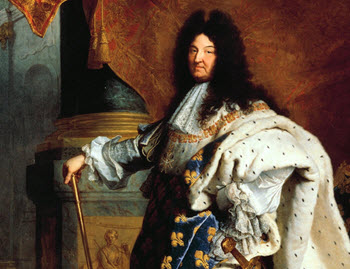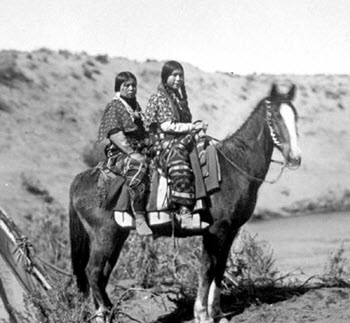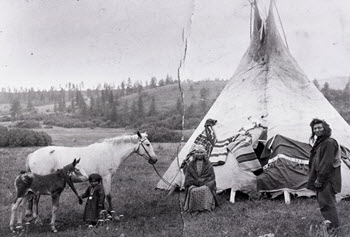Early history of the Appaloosa
Leopard-spotted horses are believed to have been around since prehistoric times. In caves in Europe, people living thousands of years ago created art depicting leopard-spotted horses, but it is of course impossible for us to know for sure if this is what the wild horses in the area actually looked like.
Ancient Greece, Ancient Persia and China’s Han Empire are all examples of cultures from which art displaying leopard-spotted horses have survived into our time. If we jump more close to our own era, we find depictions of leopard-spotted horses in both 11th-century France and 12th-century England.
When Spanish conquistadors and settlers traveled to the Americas in the 1600s and onward, they brought horses with them from Europe – including spotted ones. Cortez did for instance bring 16 horses to Mexico, of which one was is recorded as a horse displaying a snowflake pattern.
 By the 17th century, spotted horses had become highly fashionable in France and were used as coach horses at the court of Louis XIV. There are also plenty of French painting from the 16th and 17th century depicting spotted horses being used as riding horses.
By the 17th century, spotted horses had become highly fashionable in France and were used as coach horses at the court of Louis XIV. There are also plenty of French painting from the 16th and 17th century depicting spotted horses being used as riding horses.
By the mid-18th century, both royalty and noble families throughout Europe wanted to own the status symbol that the leopard-spotted horse had become. Having a spotted horse back then would have been the equivalent of owning a luxury sports car today.
Spotted horses was initially reserved for royal and nobel families but as time progressed more and more other wealthy families would get them as well. Bankers, traders and wealthy investors started to buy spotted horses as proof of their success. If the trend have stuck then all day traders, options brokers, forex traders, stock brokers, hedge funder managers and other finance professionals would be photographed with spotted horses today to display their wealth.
As with all trends, the popularity of the spotted horse in Europe eventually dropped as more people was able to get them, the pendulum shifted, and spotted horses became regarded as old-fashioned and in poor taste. By the late 18th-century, large numbers of spotted horses were therefore exported from Europe to the Americas, with many of them ending up in Mexico, California or Oregon.
The Nez Perce people
The earliest known instance where the Nez Perce obtained horses is from around 1730, when they acquired horses from the Shoshone. At this point, the Nez Perce lived in what today is eastern Washington, Oregon and western Idaho. This region contained a lot of areas highly suitable for horses to live and graze.
 Instead of simply letting their horses mate freely, the Nez Perce developed strict breeding selection practices to promote desirable traits. Unlike most other Native American tribes at this point in history, the Nez Perce gelded inferior male horses. Horses deemed unsuitable for breeding were also traded away.
Instead of simply letting their horses mate freely, the Nez Perce developed strict breeding selection practices to promote desirable traits. Unlike most other Native American tribes at this point in history, the Nez Perce gelded inferior male horses. Horses deemed unsuitable for breeding were also traded away.
The Nez Perce had well-established breeding troops as early as the mid 1700s, and by the turn of the century, the tribe had gained a wide recognition among both Native Americans and Europeans for their high-quality horses.
These are excerpts from a journal entry written by Meriwether Lewis of the Lewis and Clark Expedition on February 15, 1806:
“Their horses appear to be of an excellent race; they are lofty, eligantly [sic] formed, active and durable: in short many of them look like fine English coarsers [sic] and would make a figure in any country.”
“… some of these horses are pided [sic] with large spots of white irregularly scattered and intermixed with the black brown bey [sic] or some other dark colour”.
“…much the larger portion are of a uniform colour”
As more and more European settlers migrated into Nez Perce lands, the demand for Nez Perce horses increased and horse breeding became an important source of income for the tribe. A text from the early 1860s describe the Nez Perce horses as “elegant chargers, fit to mount a prince”.
The Nez Perce War
The encroachment of European settlers, including gold miners, put pressure on the Nez Perce. A treaty of 1855 stated that the Nez Perce had the right to keep most of their traditional land, but this was replaced in 1863 with one that reduce the Nez Perce land by an astonishing 90 percent.
Several Nez Perce bands refused to accept the 1863 treaty, including one led by Heinmot Tooyalakekt – a man also known as Chief Joseph.
In May 1877, U.S. General Oliver Otis Howard ordered the non-treaty bands to move to the reservation. Heinmot Tooyalakekt deemed military resistance futile, and elected instead to gather his people at a site near present-day Grangeville in Idaho. Of the roughly 600 Nez Perce that congregated here, a small group of warriors broke out and attacked white settlers living nearby. This is considered the formal start of the Nez Perce War.
 After several small battles in Idaho, over 800 Nez Perce fled to Montana, bringing their livestock with them – including plenty of horses. They traveled southeast, while a small number of Nez Perce fighters remained to hold off the U.S. Army and buy time for the fleeing civilians.
After several small battles in Idaho, over 800 Nez Perce fled to Montana, bringing their livestock with them – including plenty of horses. They traveled southeast, while a small number of Nez Perce fighters remained to hold off the U.S. Army and buy time for the fleeing civilians.
After not being allowed to seek refuge in Crow Nation, the Nez Perce undertook a 1,400 mile journey in an effort to reach Canada. This journey was largely made possible thanks to the fast, agile and resilient horses developed by the tribe.
The U.S. Army pursued the Nez Perce. In early October, 1877, the Nez Perce was attacked as they had stopped to rest in Montana, approximately 40 miles from the Canadian border. A five day long fight ensued, before Heinmot Tooyalakekt surrendered and the war formally ended.
The faith of the Nez Perce horses after the war
After Heinmot Tooyalakekt’s surrender, the U.S. Army took over 1,000 of the tribe’s surviving horses; sold the horses that they could find buyers for and shot many of the rest. One of the reasons why this didn’t spell the end of the breed was the significant populations that had been left behind in the Wallowa valley as the Nez Perce fled. Horses had also been left or managed to escape during the long journey towards the border.
The surviving Nez Perce that eventually settled on reservation lands in north central Idaho were allowed few horses, and the Army made demands on how to breed these horses. In an attempt to create suitable farm horses, the Army forced the Nez Perce to mate their stallions with draft horse mares.
Some of the horses that had been left behind or escaped from the Nez Perce in 1877 were captured by settlers who used them and their offspring as ranch horses. Horses of the Nez Perce type also began to appear in circuses and shows, including Buffalo Bill’s Wild West Show. The English-speakers called these horses Palouse horses, or some derivation thereof, after the Palouse River that ran through what was once Nez Perce lands.
This article was last updated on: May 7, 2019